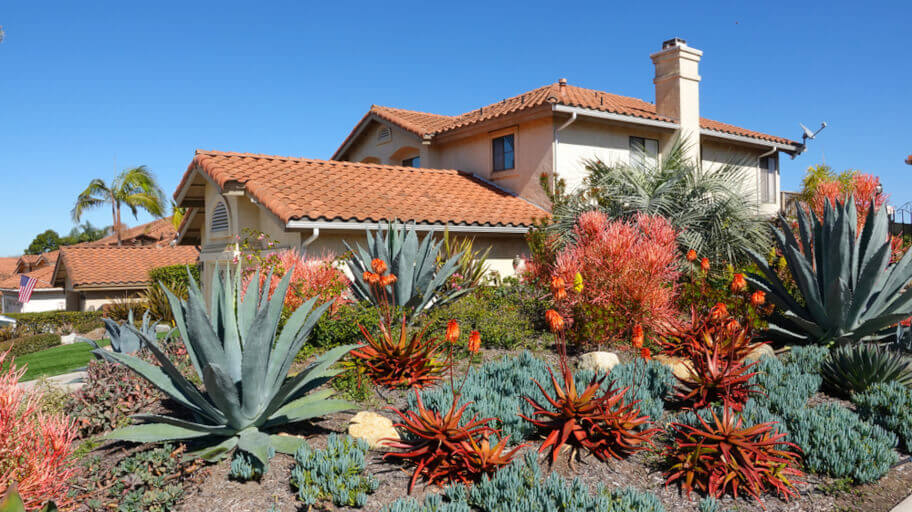
Let’s face it. Straya is not exactly known for it’s wealth in water. So today we’ll be exploring a landscaping method that centers around using as little of it as possible and still achieving great results. While xeriscaping sounds much like what a xenobotanist may do, the reality (unfortunately) isn’t at all sci fi. It’s perfectly applicable to your Melbourne garden, and can save you time and money in the long run.
What is Xeriscaping?
The word “xeriscaping” comes from the Greek word “xeros” meaning dry. It’s a method of gardening that drastically reduces or completely eliminates the need of supplemental irrigation. It emphasises the use of endemic plants and managing loss of water due to runoff and evaporation. Not only that but the principles behind xeriscaping also reduce the needs for other things like fertiliser and pest control. As you may have already figured out, xeriscaping fits snugly together with permaculture, offering advantages such as:
- Lowers consumption of water – As much as 75%. Eliminates it completely if you go for a desert landscape. If you are recycling water at your household or pay close attention to the water bill, you’ll recognise how much this is.
- Reduces maintenance – Aside from mulching and occasional weeding xeriscape gardens require almost no maintenance to thrive.
- Improves rainwater retention – With appropriate soil grading, mulching and plant grouping, you can take full advantage of rainfall no matter how rare.
- Saves money – Xeriscaping additionally reduces the need for fertilisers and equipment. This is in part because the lawn space in these garden is greatly reduced.
- Reduces waste and pollution – The less fertilisers used the smaller the contribution to the urban runoff pollution.
Xeriscaping principles
We’ve created a detailed list of all principles you can learn.
1. Plan and design
The most important aspect of xeriscaping is water conservation. To be able to effectively do that, you will have to thoroughly research the plot where you want to establish the garden. Take your time to learn everything from the contours of the terrain to soil absorption and drainage patterns. Then start planning following these basic points.:
- Mark down North, South, East, and West on the graph paper. Put down any limiting features such as buildings, garden furniture, and already established plants. Outline zones of sun and shades which will also make for differing water needs. You’ll want to group plants with similar needs for water to optimise the effectiveness of watering
- Once you’ve learned the contours of your land, you may want to consider developing terraces wherever there’s a rise in the ground, instead of trying to flatten it. Terraces protect the soil against erosion from rain and irrigation. The levels can be as short as 8cm, but anything above 30cm will require considerable support. This can come in the form of wood boards supported with metal stakes, rock walls, or an apprentice level Terraced Earth enchantment from your local garden warlock.
- Areas for seating, dining, play, visual barriers, decking, and others that will be used for anything but the garden itself should also be marked in the plan.
- Turf areas should be designed to be easy to mow. Curved shapes are more lawn mower friendly than square ones with sharp corners.
- Large plants such as shrubs and trees could be used to provide natural means of cooling areas not only in your garden, but your home as well. They could even be used as insulation. Both will work with proper planning and positioning.
2. Soil amendment
The two most important qualities for the soil of a water-conserving garden are drainage and water retention. The key is keeping it well aerated and rich in organic material. For the purpose of enriching the soil, compost will be your best friend.
That is unless you are creating a xeriscape comprised of succulents and cacti. Lean soil is preferred for these two species. Soils in the Melbourne region tend to be on the acidic side, but this can be fixed by adding bone meal.
Nevertheless, it’s recommended that you test your soil before starting a garden.
3. Efficient irrigation
Unless you are going for a desert landscape you will sometimes have to provide what rain doesn’t. To this extent, we recommend installing a drip irrigation system. Some people recommend soaker hoses, but we find that drip irrigation is more precise, thus saves more water and delivers it exactly where it’s needed. Additionally, it is easier to maintain, since if the soaker hose springs a leak you will either have to replace the whole length or go through the potentially nerve-wracking procedure of patching it. Regardless of recommendation, both will work for a xeriscape.
Plants prefer infrequent deep waterings more than frequent shallow ones and since both of these systems deliver small amounts of water directly into the soil, this is the perfect solution. Due to the slow delivery, it will also promote root absorption in your plants and will safeguard the soil against erosion.
4. Appropriate plant and zone selection
Native plants work best for xeriscapes. Luckily our continent is in no short supply of drought-tolerant plants. Some of them have actually adopted fire in their life cycles! You can find a complete list of drought-resistant plants customized for the Melbourne area and soils right here. You should also keep in mind:
- When selecting plants, do so for their ultimate size. Keep it in mind when creating your plan. This will reduce the need of pruning in case the plant turns out too big for the spot you picked and will in turn cut down on your green waste.
- In the drier areas, typically those with southern or western exposure, put down plants with the lowest water requirement. Plants with higher moisture needs should be placed in north and east-facing positions, as well as along walls and slopes with the same orientation. The most important thing is not to mix plants with different requirements in your planting areas.
- Trees shade the ground and block winds, which helps minimizing evaporation when used with consideration.
5. Mulch
Mulching is essential for xeriscaping because it helps the soil retain moisture and temperature, and keeps weeds at bay. For maximum efficiency, you should not leave any patches of soil exposed. Leaves, coarse compost, wood chips, grass clippings, gravel, etc. will all work as mulch. The options are many and each type of mulch has its own uses. Pick the best one for your specific garden.
Organic mulch is likely the best option since it will slowly incorporate into the soil and is a way to recycle green waste from your garden, the only drawback being that you’ll have to reapply it from time to time. The optimal mulch depth is between 12cm and 15cm. Running the irrigation hoses under the mulch will not only make your garden look much neater, but will also make sure the moisture goes directly where it needs to and stays there!
6. Limited turf areas
Another important tenet of xeriscaping. Turf areas typically require lots of watering, so keeping them to a bare minimum is a must. Limit the use of turf to functionality open spaces and strategically placed visual appeal. You can consider decking to provide an aesthetic and functional way of covering up bald spots.
7. Maintenance
While xeriscapes require much less maintenance than normal landscapes, there’s still some garden maintenance to be done once in a while. This comes mainly in the form of weeding if the pesky buggers manage to bypass the top dressing. Trees and shrubs may require the occasional pruning too. Keeping your turf grass longer is a good idea since it will protect the soil better and act as a natural mulch. Be careful not to over fertilise. Trees and shrubs may require occasional pruning.
Need help around the garden?
We are available!









Outdoor irrigation makes up a good percentage of summer water consumption in a number of Australian cities. A few options exist to tackle this; mass efforts to let lawns brown is one and thinking Xeriscaping is also another one. Is it time that Xeriscaping
is promoted as part of wider water conservancy initiatives by regional and city councils across Australia and by Landscape Architecture schools and faculties?